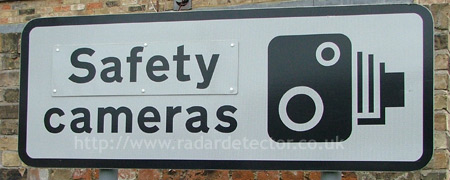Are the government providing us with accurate information about speed enforcement?
As more people who had gone through life considering themselves to be perfectly respectable and law abiding citizens are criminalised by automated enforcement equipment, public opposition to the government's stance on road safety has increased. Pressurised by this, various government and "safety camera partnerships" have made claims which appear wholly insubstantial or inaccurate, and information provided from different bodies can seem wildly inconsistent.
Claim:
The majority of people within the UK support the use of automated speed enforcement devices.
Inconsistency:
If this is the truth, why did the government and local camera partnerships feel the compelling need to suddenly change the term used to describe them? This can clearly be seen in the sign below which has had the word "safety" hastily applied over the word "speed" as part of this governmental rebranding.

It is also difficult not to question whether the government's claim is at odds with other available evidence. Generally speaking, people within the UK are highly tolerant and largely law abiding. It is slightly unusual therefore that large numbers of GATSO and similar cameras have been vandalised, presumably by those same tolerant law abiding citizens who now believe that they have unfairly been criminalised by automated enforcement equipment.
Claim:
Excessive speed is a contributory factor in over 1,000 deaths and over 38,000 injuries every year.
Source: The Think! Road Safety Website, as updated 11/01/05
Inconsistency:
Research by the Transport Research Laboratory concluded that speed was a "definite" causal factor in 126 out of 2897 accidents. Most cases where speed was a definite factor occurred as a result of loss of control of a vehicle in an urban area. Typically, accidents of this nature are caused by extreme recklessness rather than the average driver exceeding the speed limit by a few mph, ie. not the drivers currently being targetted by government road safety schemes.
It could be argued that the conclusions drawn by the Transport Research Laboratory's research are inaccurate. To summarise that speed is a definite cause ignores the fact that this excess speed may in itself be better attributed to poor driver awareness or lack of experience. However, assuming that the research is accurate, the figures concerned equate to just 4.3% of accidents. This leaves the cause of nearly 96% of accidents unaddressed by current government road safety campaigns, which appear to almost solely target speed (with the exception of seasonal campaigns against drink driving).
Using the Transport Research Laboratory's conclusion that 4.3% of road accidents are related to speed, we can calculate the number of road deaths that would occur overall, assuming the government's claim is correct.
(1000 / 4.3) x 100 = 23,255 total deaths.
At the time of the Transport Research Laboratory's research, total road deaths were actually around 3,500.
Using the same information, we can calculate a theoretical number of road injuries based on the goverment's information.
(38000 / 4.3) x 100 = 883,720 total injuries.
At the time of the Transport Research Laboratory's research, total road injury figures were actually around 360,000.
One thing which is apparent is the sheer scale of death and injury on our roads. What is less apparent is how the government defines which accidents occur as a result of speed and why little, if anything, is being done to address the more common causes.
Claim:
Safety Cameras Save Lives
Inconsistency:
Speed cameras were first introduced into the UK in 1992. Their use was however not widely adopted until 1994. Since that time, the number of cameras has rapidly increased, and now stands at around 4,500. If government information is correct, you would therefore assume that the number of road deaths would have been significantly reduced as a result. In reality:-
- Annual road death figures reduced by a bigger margin in each of the three years before the introduction of speed cameras than they did in the ten years since.
- From 1984 to 1993, road deaths fell by 32%. From 1993 to 2003, deaths have dropped by only 3.8%.
- In 2003, the number of road deaths in the UK rose by 1.3%.
- The fatal accident rate, which has consistently fallen by 5-7% each year for the last 50 or so years reversed during 2003.
All of the above is at odds with Department for Transport figures, which claim that roads with speed cameras have seen a 35% drop in deaths and serious injuries. if the DfT figures are correct, then this suggests that speed cameras do not prevent road traffic accident and injury, but may in fact cause them to occur in different locations.
Since 1996, the number of dedicated road traffic Police officers has fallen by 11%. As yet, no conclusive research appears to have been conducted to assess whether this may be leading to an increase in road deaths.
|

